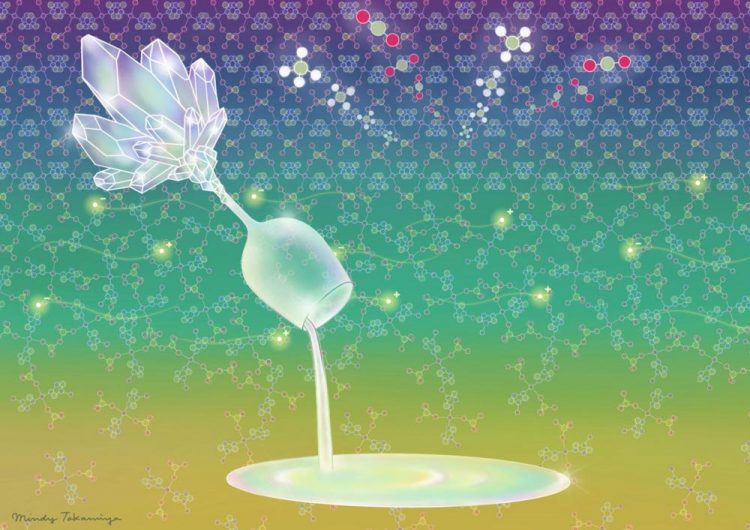New state-of-the-MOF materials

The novel DNA-binding molecule combines multiple tools into a single synthetic platform, like a chemical Swiss knife. Credit: Illustration by Mindy Takamiya (CC BY 4.0)
Metal-organic frameworks (MOFs) are porous, crystalline materials that can trap compounds within their molecular cavities, giving them a wide range of applications in gas storage and separation, carbon capture, and in the catalysis of chemical reactions, to name a few.
A new range of applications are now being investigated by converting crystalline MOFs into liquid and/or glassy states.
“MOFs are a relatively new class of material, and most of those developed in the last 20 years are in the crystalline state,” says Satoshi Horike, a materials scientist of Kyoto University's Institute for Integrated Cell-Material Sciences (iCeMS). “Recently, we have found non-crystalline glass or liquid states in MOFs and propose they have great potential as future materials.”
Horike reviewed the latest advancements and perspectives in the field, together with material chemist Susumu Kitagawa and colleagues for the journal Angewandte Chemie International Edition.
Tens of thousands of MOFs have been synthesized since they were first discovered in the late 1990s. Technology advances are now allowing researchers to uncover what happens at the molecular level when some MOFs are heated to a melting point and then cooled to produce a glass-like state.
So far, researchers have reported about ten MOFs that can be melted into a liquid and/or turned into a glass state. Their melting temperatures range from 184°C to 593°C, depending on their crystal structures.
When this type of MOF is heated, its metal ions and organic ligands start to wobble within the crystals as the material melts. The bond distances in its polymer chains also lengthen as temperatures continue to rise. The structure of a MOF's crystalline state is very ordered.
The glass state has a 'middle-range order', where the connections break but portions of the extended structure remain generally in place. Much more molecular fragmentation occurs when a MOF reaches the liquid state, but some of its internal structure retains an element of connectivity.
Not all of these MOFs can be transformed into glass by cooling their liquid state. Some require a mechanical grinding-like treatment for glass to form. During this process, adding certain chemicals to the material could modulate some of its physical properties, such as enhancement of proton conductivity.
Liquid and glass MOFs could provide a new state of material that demonstrates porosity, ion conductivity, and optical properties such as luminescence. They also show promise for heat storage, in energy devices, and for gas permeation. Hybrid materials incorporating glass or liquid MOFs with other materials, such as organic polymers, metal particles, or metal ions, could be used as strong adhesives in energy devices or in catalytic reactions.
The researchers suggest that scientists should revisit the huge library available for crystalline MOFs from the viewpoint of phase change to liquid and/or glass. Doing so could lead to the design of new functional materials.
###
DOI: 10.1039/c9cc09608f
About Kyoto University's Institute for Integrated Cell-Material Sciences (iCeMS)
At iCeMS, our mission is to explore the secrets of life by creating compounds to control cells, and further down the road to create life-inspired materials.
https:/
For more information, contact
I. Mindy Takamiya/ Mari Toyama
pe@mail2.adm.kyoto-u.ac.jp
Media Contact
More Information:
http://dx.doi.org/10.1002/anie.201911384All latest news from the category: Materials Sciences
Materials management deals with the research, development, manufacturing and processing of raw and industrial materials. Key aspects here are biological and medical issues, which play an increasingly important role in this field.
innovations-report offers in-depth articles related to the development and application of materials and the structure and properties of new materials.
Newest articles

Superradiant atoms could push the boundaries of how precisely time can be measured
Superradiant atoms can help us measure time more precisely than ever. In a new study, researchers from the University of Copenhagen present a new method for measuring the time interval,…

Ion thermoelectric conversion devices for near room temperature
The electrode sheet of the thermoelectric device consists of ionic hydrogel, which is sandwiched between the electrodes to form, and the Prussian blue on the electrode undergoes a redox reaction…

Zap Energy achieves 37-million-degree temperatures in a compact device
New publication reports record electron temperatures for a small-scale, sheared-flow-stabilized Z-pinch fusion device. In the nine decades since humans first produced fusion reactions, only a few fusion technologies have demonstrated…





















